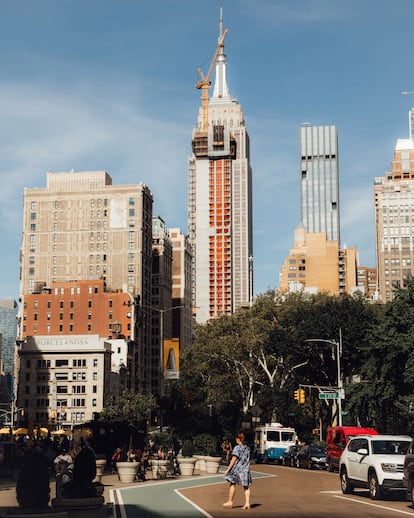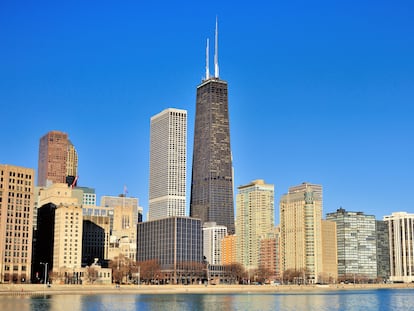Get that skyscraper out of my face!
The construction of a tall new building blocking views of the Empire State Building sparks a debate on regulating the Manhattan skyline

The word “skyscraper” has many definitions, but a particularly brilliant one can be found in the book and podcast The 99% Invisible City by Roman Mars and Kurt Kohlstedt. They describe it as a machine designed to convert land into money. As cities started to expand, their vertical growth became driven by economic factors. Scaling such heights required remarkable technological advancements, and we are fortunate that Mr. Elisha Otis invented safe elevators in 1854. The race to the heavens that began in Chicago so many years ago is still going strong.
The New York Times architecture critic Michael Kimmelman published a long article in October 2023 titled When the Skyscraper You Hate Blocks the Skyscraper You Love. He was talking about the Empire State Building, a remarkable and massive tower that was embraced by New Yorkers in 1931 when it became the tallest building in the world, symbolizing triumph over the Great Depression. It housed office workers, garment workers, bankers and diamond merchants. Until recently, when you left the Flatiron Building and walked into Madison Square near Fifth Avenue, you could catch a glimpse of the Empire State Building. Now, if you head towards the northwest corner of the park, all you can see is a nondescript skyscraper blocking views of the building that symbolizes New York City. According to Kimmelman, in 1931, a dollar would grant you access to the observation deck of the Empire State Building, providing a godlike view of New York City. The Empire State Building connected New Yorkers to their ever-changing skyline, much like the Brooklyn Bridge transformed it back in 1883. Kimmelman laments that a visit to the building’s top observation decks will now cost you $79, just so you can see a new 860-foot (260-meter) luxury residential tower. Is this progress? Should New York consider regulating its skyline?
Miriam Berman, the author of Madison Square: The Park and Its Celebrated Landmarks, is also a conservationist and tour guide who likes to encourage visitors to appreciate the visual connection between the Flatiron Building and the Empire State Building across Fifth Avenue. Berman believes that preserving this line of sight is just as important as protecting a historical monument.

The Empire State Building has faded from view because of “another anorexic, super-sized indulgence for millionaires rising up from 29th Street,” says Kimmelman. He recalls how he used to emerge from the subway and glance upward at the city’s iconic skyscrapers to orient himself. He even remembers the Twin Towers designed by Minoru Yamasaki, an architect who was afraid of heights.
New York’s unrecognizable skyline is now occupied by apartments for billionaires that reflect the city’s growing income gap and skyrocketing housing costs, writes Kimmelman. The pencil-thin new building at 262 Fifth Avenue that spoils views of the Empire State Building was designed by the Russian architectural firm Meganom. According to Crain’s magazine, it will have 56 floors but only 26 (huge) apartments!
Fortunately, the Empire State Building can be seen in all its splendor from 28th Street, which reminds us of what Fran Lebowitz said about the city’s skyscrapers in her documentary, Pretend It’s a City. “The amazing thing about the Chrysler Building is all the little details and how beautiful it is. I think it’s for sale. I’m not gonna buy it or anything, but to me, it’s the perfect size for a one-person house.”
Sign up for our weekly newsletter to get more English-language news coverage from EL PAÍS USA Edition
Tu suscripción se está usando en otro dispositivo
¿Quieres añadir otro usuario a tu suscripción?
Si continúas leyendo en este dispositivo, no se podrá leer en el otro.
FlechaTu suscripción se está usando en otro dispositivo y solo puedes acceder a EL PAÍS desde un dispositivo a la vez.
Si quieres compartir tu cuenta, cambia tu suscripción a la modalidad Premium, así podrás añadir otro usuario. Cada uno accederá con su propia cuenta de email, lo que os permitirá personalizar vuestra experiencia en EL PAÍS.
¿Tienes una suscripción de empresa? Accede aquí para contratar más cuentas.
En el caso de no saber quién está usando tu cuenta, te recomendamos cambiar tu contraseña aquí.
Si decides continuar compartiendo tu cuenta, este mensaje se mostrará en tu dispositivo y en el de la otra persona que está usando tu cuenta de forma indefinida, afectando a tu experiencia de lectura. Puedes consultar aquí los términos y condiciones de la suscripción digital.
More information
Archived In
Últimas noticias
David Bowie, the galactic thinker who encouraged us to break new ground
John Berger and the loss of rural culture
From police officer to bloodthirsty kidnapper: Terror in Mexico during the years of ‘The Ear Chopper’
Alain Aspect, Nobel laureate in physics: ‘Einstein was so smart that he would have had to recognize quantum entanglement’
Most viewed
- David King, chemist: ‘There are scientists studying how to cool the planet; nobody should stop these experiments from happening’
- Reinhard Genzel, Nobel laureate in physics: ‘One-minute videos will never give you the truth’
- Oona Chaplin: ‘I told James Cameron that I was living in a treehouse and starting a permaculture project with a friend’
- Mexico completes its trade shift with the entry into force of tariffs on China and countries without trade agreements
- Sinaloa Cartel war is taking its toll on Los Chapitos











































